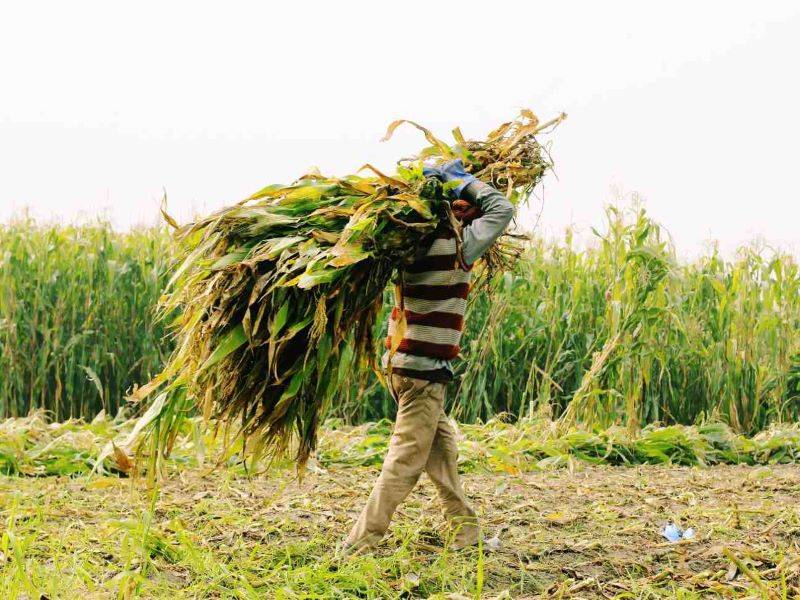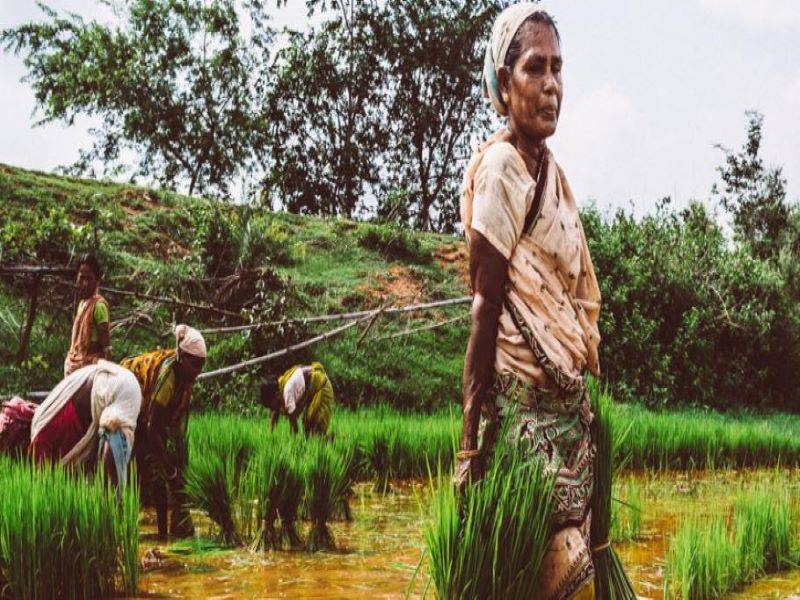
Agricultural production declined due to lack of rainfall, the adaptation of modern techniques and reduction in the interest of local farmers has resulted in the loss of farming. From the time civilizations and spread of agriculture on the river banks was due to the availability of fertile land around it but due to over-cultivation and poor farming practices land has lost its fertility. The impact is not only still losing land fertility, but have also lost the traditional culture Indian agricultural or harvest festivals like Makara Sankranti, Pongal, Uttarayana, Lohri, Poush, Parbon, and Bhogali Bihu etc. Agriculture was the mode of subsistence of majority of the population that continued till medieval and British era. In British era certain policies like Permanent Settlement, Zamindari system, Ryotwari System, Mahalwari System and neglect of land development left Indian farmers in misery with famine in villages became a common phenomenon.

Hence in our national movement, Mahatma Gandhi, Acharya Vinoba Bhave, Sardar Vallabhbhai Patel along with other leaders talked about land reforms, for poor Farmer’s Swaraj became a symbol of ending of misery, getting rights on their land. Acharya Vinoba Bhave in 1951 at Pochampally village, Telangana started Bhoodan Movement or Land Gift Movement which was a voluntary land reform movement in India. In 1951, Ninth Schedule was inserted in the Indian Constitution to protect the land reform and other laws present in it from the judicial review. Due to technological advancements, many people lost their job and Sardar Patel believed in the all-round development of farmers of India which according to him can only be done by improving their occupation. That's why he said that “I know only one culture that is agriculture.” In 1965, India had to engage in a war with Pakistan & faced the famine-like situation along with the United States threatened to cut off food supplies to India. India’s former Prime Minister Lal Bahadur Shastri promoted self-reliance rather than importing supplies from other countries. He introduced the concept of kitchen gardens in India with the slogan “Jai Jawan Jai Kisan”. In 1965 Indira Gandhi government decided to take steps on agricultural reforms by the introduction of Green revolution by M. S. Swaminathan in Haryana & Punjab areas so that India can become self-sufficient in food production, high yield seeds and spread of irrigation facilities helped farmers to produce now more than 270 metric ton of grain, which is not less than an achievement for our farmers. But the irony remains that the Green Revolution could not spread all over India and inter-state disparities were visible. Small and marginal farmer those are more than 80% of total farmers could not take benefit of new technology and their subsistence on agriculture remained impaired. After 1991, we could not pull our agriculture population into manufacturing and could not provide adequate human capital that is also a major reason why agriculture is over-employed, and could not become a source of subsistence.

Certain government initiatives on the Agricultural Sector
Marketing reforms under Agricultural Produce Market Committee (APMC) act 2003 has played a major role like there will be no compulsion on the growers to sell their produce through existing markets administered by the Agricultural Produce Market Committee (APMC). Separate provision is made for notification of 'Special Markets' in any market area for specified agricultural commodities but still eludes agricultural markets in most of the states. To resolve the problem of unpredictable nature of farming and prevents farmers suicide in the country, the government had launched Pradhan Mantri Fasal Bima Yojana-2016, which ensures crop insurance policy with relaxed premium rates on the principal sum insured for farmers. Government of India has also invested Rs 75,000 crore to provide energy-efficient irrigational facilities to farmers, by providing energy-saving pumps. To ensure the importance of soil and water for improved agricultural production, the government has also started a cluster approach, toward the mode of farming through Paramparagat Krishi Vikas Yojna (PKVY). According to this approach, 50 farmers would form a group having 50 acres of land to implement organic farming. The programme aims to set up 10,000 clusters covering 5 lakh acres under organic farming in three years. Several other government schemes such as, National Mission for Sustainable Agriculture (NMSA), Pradhan Mantri Krishi Sinchayee Yojana (PMKSY), Micro Irrigation Fund (MIF), Agriculture Contingency Plans, Rashtriya Krishi Vikas Yojana (RKVY), Soil Health Card Scheme, Crop insurance schemes like Pradhan Mantri Fasal Bima Yojana (PMFBY), Financial inclusion for smallholder farmers, Kisan Credit Card (KCC) scheme, One Nation One Market, Social security schemes like Atal Pension Yojana (APY) and has played a major role in the agricultural sector. In 2022, when India will celebrate 75 years of independence, the government has taken to double the income of farmers, this aim is necessary to be achieved to uplift our rural population especially small and marginal farmers from the deprivation. National Agriculture Market (eNAM) online trading platform for agricultural commodities in India were launched to promote price discovery and help farmers realize

the value of their product is still to take off. But the absence of clear guideline on contract farming has been a hurdle to the industry-farmer partnership.
Farmers still have to suffer despite these initiatives:
Recent deaths of farmers in Yavatmal due to inhalation of toxic pesticides, a farmer committed suicide in Muzaffarnagar’s Sisauli due to financial stress as he had not been paid his sugarcane dues are few examples of a gap in extension services. Research for the development of high yielding & climate-resistant seed varieties, sustainable agricultural practises has been slow and inadequate. Apart from that government policies in declaration and procurement of produce under Minimum Support Prices (MSP), has fueled the growth of cereal centric agriculture. This has been a major factor behind the depletion of resources, lack of diversification. Developmental schemes majorly cover middle &large scale agricultural lords and many farmers do not have their land to apply for this scheme, they just enjoy a tiny part of the profit from the owner who is covered by the welfare schemes. Lack of knowledge & awareness of the initiatives given by the government is not received or understood by the farmers at the end. In the agricultural sector, the production is sufficient but the movement of goods to the area of demand is not done appropriately. The lack of warehouse, cold storages and the lack of governments interest to directly purchase the produced goods and supply to where ever it is needed is an important cause. The weather unpredictability is also a major cause since India is monsoon nation. Many of the farmers do not get proper guidance for the usage of fertilizers, weedicides, pesticides and others issued by the government. They are still using the cheap products that are available in markets because the majority of the duplicate products occupy the markets by crossing government standard approval.
Must be done & Way Ahead:
The government should ensure that its welfare schemes are reaching to all farmers and try to involve all farmers within the government’s development vision. The traditional method of agriculture should also be conserved and promoted by keeping the balance between ecological and biological diversity. The national solar mission should also cover the agricultural sector to tackle the electricity demand in that sector. Rural & Agricultural demand affects all other sectors of the economy, so long term comprehensive strategy need to be implemented without any further delay.















